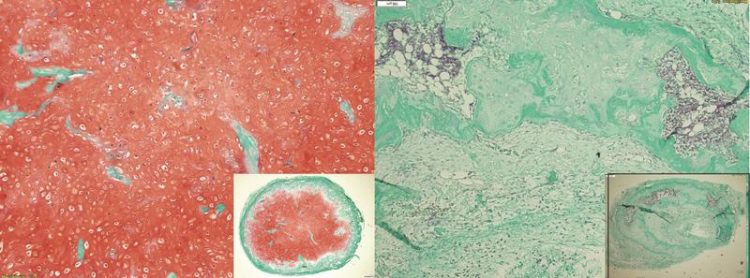Basel researchers succeed in cultivating cartilage from stem cells

Development of cartilage tissue from mesenchymal stem cells after eight weeks in vivo: Stable cartilage tissue, indicated by red staining (left), versus development towards bone tissue (right). Image: University of Basel, Department of Biomedicine
Certain mesenchymal stem/stromal cells from the bone marrow of adults are considered extremely promising for skeletal tissue regeneration. These adult stem cells usually develop into cartilage tissue which later naturally remodels into bone tissue.
Even if the stem cells are induced to differentiate into cartilage cells, they spontaneously mature into a so-called “hypertrophic” state, ultimately leading to the formation of bone tissue; this is similar to the cartilaginous tissue temporarily formed after a fracture.
Inhibiting signaling pathways
Prof. Dr. Ivan Martin’s research group at the Department of Biomedicine has now been able to demonstrate that by forcing certain molecular events occurring during the embryonic development of articular cartilage it is possible to generate stable cartilage tissue from adult human mesenchymal stem cells.
This can be achieved by inhibiting the signaling pathway of a specific protein (Bone Morphogenetic Protein, BMP). The Basel team generated these results after many years of cooperation with the Novartis Institutes for Biomedical Research, which produced and supplied the inhibitors.
Specifically, the scientists investigated two highly specific BMP receptor inhibitors in a special device (microfluid platform) developed in cooperation with Politecnico di Milano. With the use of this new technology, they were able to show that the temporary blocking of specific BMP receptors – even if only for a limited time – is sufficient to maintain stable cartilage tissue, both in the laboratory and in a mouse model.
Embryonic cartilage formation as a model
These results open new perspectives in the regeneration of articular cartilage as well as in the establishment of stem cell-based models of cartilage development, physiology, and possibly pathology. “Importantly, we have achieved our insights by mimicking molecular processes occurring during embryonic cartilage formation,” says Ivan Martin. This confirms the vital role of “developmental engineering,” in which natural processes are mimicked to control the development and specification of adult stem and progenitor cells.
Original Source
Paola Occhetta, Sebastien Pigeot, Marco Rasponi, Boris Dasen, Arne Mehrkens, Thomas Ullrich, Ina Kramer, Sabine Guth-Gundel, Andrea Barbero, and Ivan Martin
Developmentally inspired programming of adult human mesenchymal stromal cells towards stable chondrogenesis
PNAS (2018), doi: 10.1073/pnas.1720658115
Further information
Prof. Dr. Ivan Martin, University of Basel / University Hospital Basel, Department of Biomedicine, Tel. +41 61 265 23 84, E-Mail: ivan.martin@unibas.ch
Media Contact
More Information:
http://www.unibas.chAll latest news from the category: Life Sciences and Chemistry
Articles and reports from the Life Sciences and chemistry area deal with applied and basic research into modern biology, chemistry and human medicine.
Valuable information can be found on a range of life sciences fields including bacteriology, biochemistry, bionics, bioinformatics, biophysics, biotechnology, genetics, geobotany, human biology, marine biology, microbiology, molecular biology, cellular biology, zoology, bioinorganic chemistry, microchemistry and environmental chemistry.
Newest articles

A ‘language’ for ML models to predict nanopore properties
A large number of 2D materials like graphene can have nanopores – small holes formed by missing atoms through which foreign substances can pass. The properties of these nanopores dictate many…

Clinically validated, wearable ultrasound patch
… for continuous blood pressure monitoring. A team of researchers at the University of California San Diego has developed a new and improved wearable ultrasound patch for continuous and noninvasive…

A new puzzle piece for string theory research
Dr. Ksenia Fedosova from the Cluster of Excellence Mathematics Münster, along with an international research team, has proven a conjecture in string theory that physicists had proposed regarding certain equations….



